|
Rotten Library > Religion > Quantum Physics
Quantum Physics No doubt the secular humanists among you are already pissed off by this article, just because of its placement under the header of religion.
No doubt the secular humanists among you are already pissed off by this article, just because of its placement under the header of religion. But what other classification is possible for a set of beliefs that can never be verified by direct observation? In which direct observation automatically negates the validity of the observation? In which invisible forces run counter to Newton's laws of thermodynamics, allowing for everything from time travel to bilocation to teleportation to free energy (also known as zero-point extraction)? OK, OK, OK. It's probably unfair to classify quantum physics as religion. (Probably not, but let's just pretend it is to appease the secular humanists. Wink, wink.) The 20th Century played host to the most amazing set of discoveries and reversals in the history of science. What was once thought to be a world of too, too solid flesh instead melted into a miasma of multiple possibilities, solidified probabilities and verifiable impossibilities. 17th century scientist Isaac Newton had defined a world view of strictly verifiable laws, everything in its place and most things definable by a series of junior high school-level math equations. Despite the fact that he spent the better part of his life obsessed with the now completely discredited "science" of alchemy, Newton defined the parameters of existence for virtually every Western scientist for 200 years. But in the 20th Century, a new breed of scientists burst onto the scene. Albert Einstein was the most famous of these; he discovered that time and space were not the straight lines that Newton's laws demanded. Einstein put forth the radical idea that space and time were curved, and he had the math to back his ideas up. Equally important, but less well known to the public at large, were shocking new developments by a core group of scientists studying the behavior of the universe at very small scales — at the level of the atom and even smaller.
The basic principles of quantum physics are relatively simple, but their ramifications are incredibly confusing. The following gross oversimplification is presented for your amusement:
The basic concept of the atom goes back to before Christian times, but the specific understanding of the atom (the one most of you were taught in high school) we have today didn't develop until the 19th and early 20th centuries. Unfortunately, that the specific understanding (the one most of you were taught in high school) is a crock of shit.
In quantum physics, none of these things are what they seem. Despite the visceral-seeming experience of getting hit by a bolt of lightning, the fact is that electrons in a reasonably meaningful sense do not exist, let alone orbit those atoms. The root contradiction of quantum physics is a principal called complementarity. Complementarity means that certain properties can't be measured simultaneously. Usually, this means you can't measure BOTH the location and trajectory of a particle. In fact, when you measure one of these qualities the other one more or less ceases to exist. So if we were talking about a baseball in the air, for instance, you couldn't measure both the direction it's moving in and also measure its location. While this might seem weird intuitively, it's not actually that hard to grok. To measure the direction in which a baseball is flying, you need to observe it in at least two different locations, right? So you technically can't measure a single location and a trajectory at the same time. What's different in quantum physics is that, according to most versions of the story, the baseball's location isn't just unmeasurable, but it ceases to be meaningful. Despite the unmeasurable location of the baseball, you can still bounce it off a bat, or your head, and it feels pretty meaningful. But if you try to measure the trajectory of an electron, for instance, as it theoretically orbits the center of an atom, the location mutates into something entirely different. The location of an electron in this instance is described as a "cloud of probabilities." This means the electron does not exist in any one location, but it instead exists as a sort of phantom, in every possible location, all at once, surrounding the electron like a cloud instead of orbiting it like a planet.
Take the photon, a particle of light. It's a funny beast that defies all logic in its travels around the universe. The photon is a particle. We know this for sure. It's a measurable, definable particle. You know how you're reading this article? Photons. If the photon was not a measurable particle, you would be staring at a blank screen, which would be pointless because the retinas in your eyes wouldn't be working either. For TVs, computer monitors, remote controls, fiber optics, eyes, tanning booths and solar power to work at all, light has to be a particle. Except that it's also a wave. Now if you went to the wrong high school, like I did, someone probably explained this to you by saying that light is actually a wave made of particles (in the same way waves of water are made of water molecules). This is an elegant explanation. Wrong, but elegant. See, light's a particle but it exists as part of a wave of "probability." In other words, there's a wave shape that describes every possible trajectory that the photon can move in. That part's easy enough. The hard part is that the wave of probability isn't just an abstract concept, it has an actual physical existence — and the probabilities can affect actual objects and events even when they don't, technically, exist. There's a famous quantum physics experiment called the "double-slit experiment," which was one of the first proofs that all this wacky shit was actually true. In the double-slit experiment, you shine a light through a piece of cardboard with two small slits that allow the light to pass through. On the other side of the cardboard, is a piece of film. When the photon hits the film, it leaves a spot, so you can measure where the individual photons land.
Intuitively, this is pretty simple: One photon, two slits. The photon has to go through one or the other slit. So what you'd expect is to find a whole bunch of photons grouped near each of the slits, since the photons obviously went through either one slit or the other.
But when you have two slits, everything gets insane. Instead of two clumps, you get a pattern, as if a wave had simultaneously hit both slits, passed through and became two waves which interfered with each other. THERE IS A WAVE! BUT THERE ISN'T! There are only photons, one after another. When the photon can only go through one slit (one possible course), there is only one photon traveling in a line. When there is more than one possibility, the single photon no longer exists; it becomes a wave of imaginary photons traveling along various possible paths. Nevertheless, when the photon eventually lands on the film, there's only one photon. If you only release one photon at a time, you still get the interference pattern, even though there's no possibility of more than one photon on the path at the same time. ARGH! Has your head exploded yet? The wave is a real thing. It affects where the photon lands. But the only way it can be real is if the photon actually exists in every possible place it could exist at the same time, which it clearly doesn't. But the experiment works in exactly the way described, which means all this is true. From this point, all bets are off. Once you accept the paradox that unrealized probabilities have a tangible existence, almost anything becomes possible.
And it gets weirder every day. Have you seen the commercial for the Volkswagen Passat where the guy gets the phone call from his future self? Just wait until you get that quantum cell phone... Sky's the limit... |
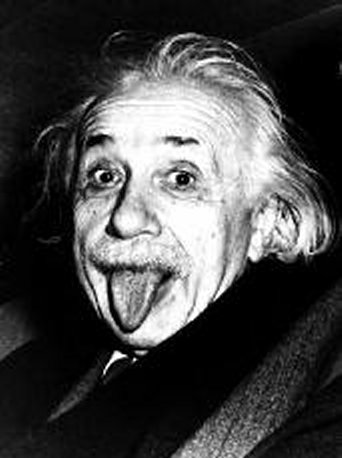 This group of mostly men included Einstein himself, Max Planck, Niels Bohr, Werner Heisenberg, Erwin Schrodinger, and dozens of others. Together and often dramatically apart, these men developed the study of these very small phenomena into what we now call quantum physics.
This group of mostly men included Einstein himself, Max Planck, Niels Bohr, Werner Heisenberg, Erwin Schrodinger, and dozens of others. Together and often dramatically apart, these men developed the study of these very small phenomena into what we now call quantum physics.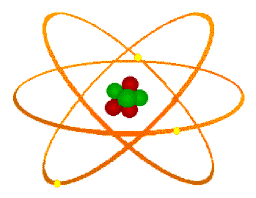 Take the electron. Remember how you learned that the electron orbits the atom? Crap. How about light? Remember the discussion of whether light was made of waves or particles or both? Crap.
Take the electron. Remember how you learned that the electron orbits the atom? Crap. How about light? Remember the discussion of whether light was made of waves or particles or both? Crap. 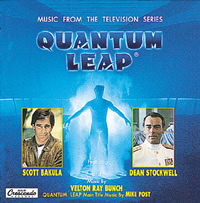 Once you see this sort of thing happening, as you might imagine, the domino effect kicks in and the weirdnesses start to multiply.
Once you see this sort of thing happening, as you might imagine, the domino effect kicks in and the weirdnesses start to multiply. 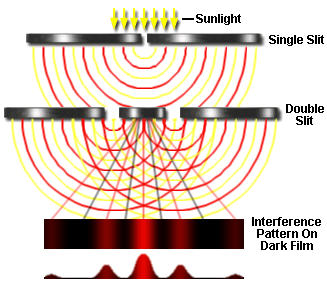 And if you only have one slit, that's actually what you get, a clump of photons near the slit. THERE IS NO WAVE!
And if you only have one slit, that's actually what you get, a clump of photons near the slit. THERE IS NO WAVE!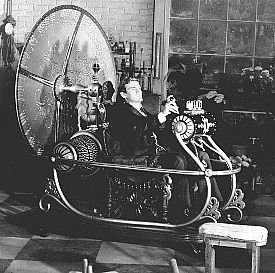 As you extend quantum physics out from this central paradox, a lot of science fiction concepts become potentially real, among them:
As you extend quantum physics out from this central paradox, a lot of science fiction concepts become potentially real, among them: